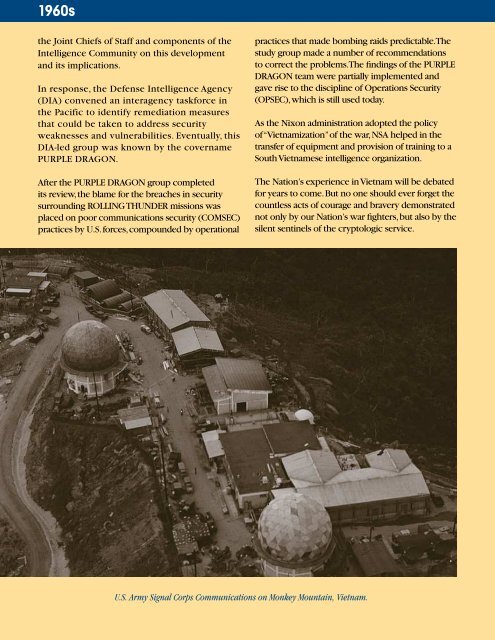National Security Agency - The Black Vault
National Security Agency - The Black Vault
National Security Agency - The Black Vault
- No tags were found...
You also want an ePaper? Increase the reach of your titles
YUMPU automatically turns print PDFs into web optimized ePapers that Google loves.
1960s<br />
the Joint Chiefs of Staff and components of the<br />
Intelligence Community on this development<br />
and its implications.<br />
In response, the Defense Intelligence <strong>Agency</strong><br />
(DIA) convened an interagency taskforce in<br />
the Pacific to identify remediation measures<br />
that could be taken to address security<br />
weaknesses and vulnerabilities. Eventually, this<br />
DIA-led group was known by the covername<br />
PURPLE DRAGON.<br />
After the PURPLE DRAGON group completed<br />
its review, the blame for the breaches in security<br />
surrounding ROLLING THUNDER missions was<br />
placed on poor communications security (COMSEC)<br />
practices by U.S. forces, compounded by operational<br />
practices that made bombing raids predictable. <strong>The</strong><br />
study group made a number of recommendations<br />
to correct the problems. <strong>The</strong> findings of the PURPLE<br />
DRAGON team were partially implemented and<br />
gave rise to the discipline of Operations <strong>Security</strong><br />
(OPSEC), which is still used today.<br />
As the Nixon administration adopted the policy<br />
of “Vietnamization” of the war, NSA helped in the<br />
transfer of equipment and provision of training to a<br />
South Vietnamese intelligence organization.<br />
<strong>The</strong> Nation’s experience in Vietnam will be debated<br />
for years to come. But no one should ever forget the<br />
countless acts of courage and bravery demonstrated<br />
not only by our Nation’s war fighters, but also by the<br />
silent sentinels of the cryptologic service.<br />
<strong>The</strong> Liberty<br />
In 1967 tensions were once again rising<br />
in the Middle East between Israel and her<br />
Arab neighbors. Hoping to collect critical<br />
intelligence in the region, the USS Liberty was<br />
sent to the eastern Mediterranean. <strong>The</strong> ship,<br />
manned by a full complement of Navy SIGINT<br />
personnel and three NSA civilians, was on<br />
station just as the Six-Day War broke out.<br />
U.S. Navy ships were ordered to draw back at least<br />
100 miles from the area of operation; however,<br />
due to a host of errors, the Liberty did not get<br />
the message. On the afternoon of June 8, while<br />
steaming off the coast of Israel, the ship was<br />
attacked by Israeli Navy and Air Defense Forces.<br />
Thirty-four crew members were killed and 171<br />
wounded, and the ship itself was badly damaged.<br />
Commander William McGonagle, the ship’s<br />
captain, despite being wounded, was able to<br />
direct a robust salvage operation that somehow<br />
managed to keep the ship afloat. For his bravery,<br />
heroism, and actions in saving the ship and<br />
administering to his crew, McGonagle would<br />
later be awarded the Medal of Honor.<br />
<strong>The</strong> Ears<br />
of Neptune<br />
<strong>The</strong> critical work of the USS Oxford during the<br />
Cuban missile crisis prompted the “powers that<br />
be” in the community to expand the program<br />
of U.S. Navy ships collecting critical SIGINT.<br />
Like U.S. Navy ships everywhere, cryptologic<br />
vessels like the Oxford were a flexible asset<br />
that could be deployed on short notice<br />
and sent to any coastal location to gather<br />
pertinent and real-time intelligence.<br />
But, while these technical research ships<br />
were indeed versatile and manned by crews<br />
of talented and dedicated men, they also<br />
proved to be exceedingly vulnerable. This<br />
vulnerability led to two tragic incidents at sea<br />
involving the USS Liberty in 1967 and the USS<br />
Pueblo in 1968. <strong>The</strong>se experiences exposed<br />
the problems in the use of these ships and<br />
ultimately led to the program’s termination by<br />
the end of the decade. n<br />
Eventually, the Israeli Government apologized<br />
for the incident and attributed it to a series<br />
of errors. In addition, Israel agreed to pay<br />
compensation to the United States. After an<br />
investigation, the U.S. ultimately accepted<br />
the apology. To this day, historians continue<br />
to debate the exact nature of events that<br />
transpired, and intense controversy remains<br />
over whether or not the attack was deliberate.<br />
Despite the controversy, what can be said<br />
unequivocally is that the crew’s service and<br />
sacrifice exemplified the best traits of the<br />
U.S. Navy and the cryptologic service, and<br />
demonstrated once again that the discipline can<br />
sometimes be a dangerous one. (More information<br />
on the USS Liberty can be found on NSA.gov.)<br />
1960s<br />
U.S. Army Signal Corps Communications on Monkey Mountain, Vietnam.<br />
<strong>The</strong> Pueblo<br />
Six months after the Liberty incident, another<br />
distressing incident, involving the USS Pueblo,<br />
occurred. In 1967 North Korean aggression<br />
<strong>The</strong> USS Liberty in drydock, Malta 1967.<br />
<strong>National</strong> <strong>Security</strong> <strong>Agency</strong> 60 Years of Defending Our Nation 39

















